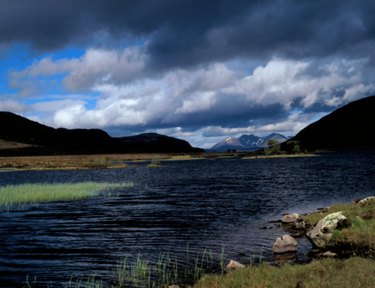
In Scotland, a moor is defined as land that is neither forested nor under cultivation. In a wider ecological sense, it consists of an uncultivated highland tract characterized by high rainfall, acidic soil, and low, scrubby vegetation. It is estimated that 12 percent of Scotland's land mass consists of moors. While a moor can refer to a wide rage of terrains, from hilltop grasslands to bogs, most of Scotland's moors are heather moorlands.
The Origins of Moors
A moor is only a partially natural feature. It consists mainly of vegetation that would form the underbrush of a forest. Left to its own devices, a heather moor would slowly return to a forested state. Moors were created by early hunters who burned the forests to flush prey animals, creating artificial clearings for grazing animals in the process. They are maintained today by periodic cycles of burning which prevent reforestation and give the moors their trademark patchwork appearance.
Vegetation
The ground cover for most Scottish moors is heather, a low, brushy evergreen shrub. There are several varieties of heather which grow and bloom at different rates, but they all produce the characteristic spearlike bunch of purple flowers. Young heather provides grazing for a range of animals including sheep, cattle, deer, and rabbits. However, if it is not burned periodically, heather will mature into woody thickets which cannot be grazed. This is another reason for the frequent burning of moorlands in Scotland.
Wildlife
Heather moors support red deer and wild rabbits and hares, and are among the only habitats for these animals in Scotland. In addition, they are the sole habitat of the red grouse, which is Britain's only native endemic species. As a result, they also support significant populations of hen harriers. The long history of moorland in Scotland has created deeply entrenched ecosystems which would not be able to survive without the existence of heather moors.
Conservation
Due to their semi-artificial nature, heather moors must be continually tended to survive. Moors are shrinking in Scotland, due to both cultivation and reforestation. While most of the reforestation is intentional, simply neglecting to burn moorlands regularly will eventually result in a slow takeover by trees, relegating heather to the underbrush. Conservation efforts are under way by environmentalists and hunters. Both groups wish to preserve the unique blends of flora and fauna that the Scottish moors support.